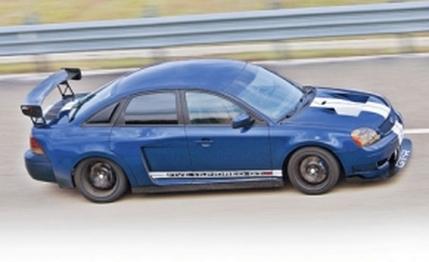 Specialty File
Specialty File
The Frankenstein Ford Five Hundred sedan you see here has a monster 590-hp supercharged powerplant from the exotic Ford GT sitting back where the rear seat used to be. Here's a startling tidbit: It was built by community-college students.
Well, okay, they got some engineering help from Ford. The story begins about a mile from our Hogback Road headquarters in Ann Arbor, Michigan, at Washtenaw Community College (WCC). The two-year school has an auto-body repair department with an interesting four-class, 12-credit curriculum called "Custom Cars and Concepts" that teaches students how to build one-of-a-kind cars like this four-door Ford.
The program was started by the head of the auto-body department, Gary Sobbry, in 2004. Sobbry is just 30, a fourth-generation auto-body repairman and car customizer who says his great-grandfather built custom cars for Al Capone. Sobbry joined WCC as an instructor in 2002, and he soon created a four-credit class in car customizing. After Sobbry purchased a new 2004 Dodge Magnum, students in his class — back then they met once a week for a full day — gave it a striking paint job and fabricated an air-suspension system for it.
That year, Dodge put Sobbry's tricked-out Magnum on its stand at the Specialty Equipment Market Association (SEMA) show in Las Vegas. And thus Sobbry was able to convince WCC administrators to fund the custom-cars program and renovate an old shop into an auto-body facility.
In early 2005, General Motors enlisted WCC to promote its new 572-cubic-inch, 620-hp crate motor it sells to hobbyists and racers for a cool $17,063. The project called for the big engine to be plugged into a 1970 Chevy Chevelle, and the build was featured on the TV show Rides.
Ford called last summer as the Chevelle was being finished. The idea for the wild GT-engined Five Hundred sedan, which in standard form bears a 203-hp V-6, was hatched over beers by two Ford engineers and a WCC auto-mechanic instructor. Perhaps not surprisingly, a Ford Five Hundred with more than 500 horsepower and 500 pound-feet of torque sounded like something that should be done.
Ford won't produce such a car and has little incentive to build one, but the trio reasoned that if Ford donated the hardware and WCC built it, the cash outlay would be minor. Ford said okay and shipped over two prototypes, a Five Hundred and a Ford GT that were bound for the crusher.
The original plan was to replace the front-mounted V-6 with the GT's supercharged V-8, mount the six-speed transmission at the rear axle, and join the two with a stiff, light torque tube. Ford would engineer the project and supply the parts, and Sobbry's students would build it. The goal was to finish the car in 10 weeks, in time for the SEMA show in November 2005.
By August 18, the GT had been disassembled and work schedules were posted. It was then that all the parties agreed on a big decision. Changing the front-driver to become a rear-drive car and grafting in the GT parts were simply too complex for the time allotted, so they went to plan B, which involved mounting the entire mid-engined Ford GT powertrain — axles to supercharger — in the rear half of the Five Hundred. Theoretically, that's not a tough job because the GT's aluminum frame is narrower than the Five Hundred's outer shell. Just gut the rear half of the Five Hundred, cut the GT in half behind the seats, and marry the rear half of the GT to the gaping hole in the Five Hundred.